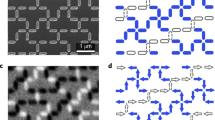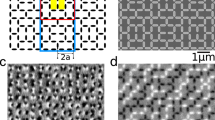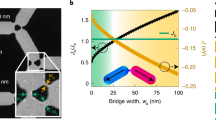Abstract
Reducing the dimensionality of a physical system can have a profound effect on its properties, as in the ordering of low-dimensional magnetic materials1, phonon dispersion in mercury chain salts2, sliding phases3, and the electronic states of graphene4. Here we explore the emergence of quasi-one-dimensional behaviour in two-dimensional artificial spin ice, a class of lithographically fabricated nanomagnet arrays used to study geometrical frustration5,6,7. We extend the implementation of artificial spin ice by fabricating a new array geometry, the so-called tetris lattice8. We demonstrate that the ground state of the tetris lattice consists of alternating ordered and disordered bands of nanomagnetic moments. The disordered bands can be mapped onto an emergent thermal one-dimensional Ising model. Furthermore, we show that the level of degeneracy associated with these bands dictates the susceptibility of island moments to thermally induced reversals, thus establishing that vertex frustration can reduce the relevant dimensionality of physical behaviour in a magnetic system.
This is a preview of subscription content, access via your institution
Access options
Subscribe to this journal
Receive 12 print issues and online access
$259.00 per year
only $21.58 per issue
Buy this article
- Purchase on SpringerLink
- Instant access to full article PDF
Prices may be subject to local taxes which are calculated during checkout





Similar content being viewed by others
References
de Jongh, L. J. & Miedema, A. R. Experiments on simple magnetic model systems. Adv. Phys. 23, 1–260 (1974).
Hastings, J. M. et al. One dimensional phonons and “phase-ordering” transition in Hg3−δAsF6 . Phys. Rev. Lett. 39, 1484–1487 (1977).
O’Hern, C. S., Lubensky, T. C. & Toner, J. Sliding phases in XY models, crystals, and cationic lipid-DNA complexes. Phys. Rev. Lett. 83, 2745–2748 (1999).
Castro Neto, A. H., Guinea, F., Peres, N. M. R., Novoselov, K. S. & Geim, A. K. The electronic properties of graphene. Rev. Mod. Phys. 81, 109–162 (2009).
Wang, R. F. et al. Artificial ‘spin ice’ in a geometrically frustrated lattice of nanoscale ferromagnetic islands. Nature 439, 303–306 (2006).
Heyderman, L. J. & Stamps, R. L. Artificial ferroic systems: Novel functionality from structure, interactions and dynamics. J. Phys. Condens. Matter 25, 363201 (2013).
Nisoli, C., Moessner, R. & Schiffer, P. Colloquium: Artificial spin ice: Designing and imaging magnetic frustration. Rev. Mod. Phys. 85, 1473–1490 (2013).
Morrison, M. J., Nelson, T. R. & Nisoli, C. Unhappy vertices in artificial spin ice: New degeneracies from vertex frustration. New J. Phys. 15, 045009 (2013).
Lammert, P. E. et al. Direct entropy determination and application to artificial spin ice. Nature Phys. 6, 786–789 (2010).
Zhang, S. et al. Crystallites of magnetic charges in artificial spin ice. Nature 500, 553–557 (2013).
Mengotti, E. et al. Real-space observation of emergent magnetic monopoles and associated Dirac strings in artificial kagome spin ice. Nature Phys. 7, 68–74 (2011).
Ladak, S., Read, D. E., Perkens, G. K., Cohen, L. F. & Branford, W. R. Direct observation of magnetic monopole defects in an artificial spin-ice system. Nature Phys. 6, 359–363 (2010).
Phatak, C., Petford-Long, A. K., Heinonen, O., Tanase, M. & De Graef, M. Nanoscale structure of the magnetic induction at monopole defects in artificial spin-ice lattices. Phys. Rev. B 83, 174431 (2011).
Pollard, S. D., Volkov, V. & Zhu, Y. Propagation of magnetic charge monopoles and Dirac flux strings in an artificial spin-ice lattice. Phys. Rev. B 85, 180402 (2012).
Morgan, J. P., Stein, A., Langridge, S. & Marrows, C. H. Thermal ground-state ordering and elementary excitations in artificial magnetic square ice. Nature Phys. 7, 75–79 (2011).
Porro, J. M., Bedoya-Pinto, A., Berger, A. & Vavassori, P. Exploring thermally induced states in square artificial spin-ice arrays. New J. Phys. 15, 055012 (2013).
Farhan, A. et al. Exploring hyper-cubic energy landscapes in thermally active finite artificial spin-ice systems. Nature Phys. 9, 375–382 (2013).
Farhan, A. et al. Direct observation of thermal relaxation in artificial spin ice. Phys. Rev. Lett. 111, 057204 (2013).
Kapaklis, V. et al. Thermal fluctuations in artificial spin ice. Nature Nanotech. 9, 514–519 (2014).
Stamps, R. L. Artificial spin ice: The unhappy wanderer. Nature Phys. 10, 623–624 (2014).
Gilbert, I. et al. Emergent ice rule and magnetic charge screening from vertex frustration in artificial spin ice. Nature Phys. 10, 670–675 (2014).
Baxter, R. J. Exactly Solved Models in Statistical Mechanics (Academic, 1982).
Zhang, S. et al. Ignoring your neighbors: Moment correlations dominated by indirect or distant interactions in an ordered nanomagnet array. Phys. Rev. Lett. 107, 117204 (2011).
Möller, G. & Moessner, R. Magnetic multipole analysis of kagome and artificial spin-ice dipolar arrays. Phys. Rev. B 80, 140409 (2009).
Donolato, M. et al. Characterization of domain wall-based traps for magnetic beads separation. J. Appl. Phys. 111, 07B336 (2012).
Ade, H. & Stoll, H. Near-edge X-ray absorption fine-structure microscopy of organic and magnetic materials. Nature Mater. 8, 281–290 (2009).
Cheng, X. M. & Keavney, D. J. Studies of nanomagnetism using synchrotron-based X-ray photoemission electron microscopy (X-PEEM). Rep. Prog. Phys. 75, 026501 (2012).
Drisko, J., Daunheimer, S. & Cumings, J. FePd3 as a material for studying thermally active artificial spin ice systems. Phys. Rev. B 91, 224406 (2015).
Lee, S.-H. et al. Emergent excitations in a geometrically frustrated magnet. Nature 418, 856–858 (2002).
Stipe, B. C. et al. Magnetic recording at 1.5 Pbm−2 using an integrated plasmonic antenna. Nature Photon. 4, 484–488 (2010).
Acknowledgements
This work was funded by the US Department of Energy, Office of Basic Energy Sciences, Materials Science and Engineering Division under grant no. DE-SC0010778. The work of C.N. was carried out under the auspices of the US Department of Energy at LANL under contract no. DE-AC52-06NA253962. Work performed at the University of Minnesota (UMN) was supported by the National Science Foundation through the UMN MRSEC under award number DMR-1420013, as well as by EU Marie Curie IOF project no. 299376. The Advanced Light Source is supported by the Director, Office of Science, Office of Basic Energy Sciences, of the US Department of Energy under contract no. DE-AC02-05CH11231.
Author information
Authors and Affiliations
Contributions
I.G., C.N. and P.S. designed this study. I.G. and Y.L. fabricated the lithographic patterns, and L.O’B., J.D.W., M.M. and C.L. optimized and deposited the wedged permalloy films. A.S., I.G. and Y.L. conducted the XMCD-PEEM measurements. I.C. assisted with data analysis. C.N. developed the theory describing the tetris lattice. I.G., C.N. and P.S. wrote the paper with input from all of the co-authors.
Corresponding author
Ethics declarations
Competing interests
The authors declare no competing financial interests.
Supplementary information
Supplementary information
Supplementary information (PDF 672 kb)
Supplementary Movie 1
Supplementary Movie (MP4 3307 kb)
Supplementary Movie 2
Supplementary Movie (MP4 15121 kb)
Supplementary Movie 3
Supplementary Movie (MP4 2879 kb)
Supplementary Movie 4
Supplementary Movie (MP4 13510 kb)
Rights and permissions
About this article
Cite this article
Gilbert, I., Lao, Y., Carrasquillo, I. et al. Emergent reduced dimensionality by vertex frustration in artificial spin ice. Nature Phys 12, 162–165 (2016). https://doi.org/10.1038/nphys3520
Received:
Accepted:
Published:
Issue date:
DOI: https://doi.org/10.1038/nphys3520
This article is cited by
-
Quantum fluctuations drive nonmonotonic correlations in a qubit lattice
Nature Communications (2024)
-
Geometrical control of topological charge transfer in Shakti-Cairo colloidal ice
Communications Physics (2023)
-
Real-space observation of ergodicity transitions in artificial spin ice
Nature Communications (2023)
-
Entropy-driven order in an array of nanomagnets
Nature Physics (2022)
-
Direct observation of a dynamical glass transition in a nanomagnetic artificial Hopfield network
Nature Physics (2022)



